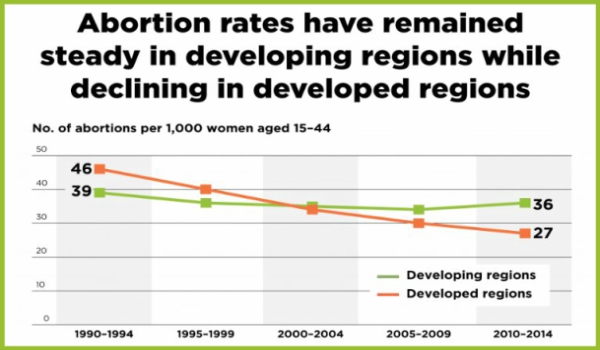
by Susheela Singh, Lisa Remez, Gilda Sedgh, Lorraine Kwok, Tsuyoshi Onda, Guttmacher Institute
This report highlights ongoing disparities in abortion rates and differential access to safe abortion services in different regions. It pulls together the latest research on abortion incidence, safety and legality, as well as on unintended pregnancy.
Although the worldwide annual abortion rate fell between 1990–1994 and 2010–2014, most of this change occurred in developed regions (from 46 to 27 abortions per 1,000 women of reproductive age); the abortion rate in developing regions hardly changed (from 39 to 36 per 1,000 women). During this same period, the global unintended pregnancy rate declined, from 74 unintended pregnancies per 1,000 women of reproductive age in 1990–1994 to 62 per 1,000 women in 2010–2014. Unlike abortion rates, unintended pregnancy rates declined substantially in both developed and developing regions.
Improved contraceptive use, and in turn, declines in unintended pregnancy rates are thought to be the likely driver behind the worldwide decline in abortion rates.
Abortion rates vary widely among world regions. Latin America and the Caribbean has the highest annual rate of abortion of any world region, 44 per 1,000 women of reproductive age, compared with 36 in Asia, 34 in Africa, 29 in Europe, and 17 in Northern America (all per 1,000 women). Latin America and the Caribbean is also the region with the highest unintended pregnancy rate—96 per 1,000 women of reproductive age. Despite Asia’s far lower rate of unintended pregnancy (54 per 1,000 women), the sheer size of its population means that nearly 54 million unintended pregnancies occur every year in that region; of these, nearly two-thirds (65%) end in abortion.
Notably, abortion rates are similar in countries where abortion is highly restricted and where it is broadly legal: The abortion rate is 37 per 1,000 women in countries where abortion is prohibited or permitted only to save the life of the pregnant woman, and 34 per 1,000 women in countries where abortion is not restricted as to reason.
Since 2000, 28 countries changed their abortion law—all but one expanding legal grounds to allow abortions to protect a woman’s health, for socioeconomic reasons or without restriction as to reason. Moreover, 24 added at least one of three additional grounds: in cases of rape or incest, or when the fetus is diagnosed with a grave anomaly.
The safety of abortions has improved because of advances in clinical guidelines and broadening legality in a number of countries. In addition, where abortion laws are highly restrictive, the increased clandestine (self-)use of misoprostol has also improved safety.
Press release (in English), also in Spanish and French



